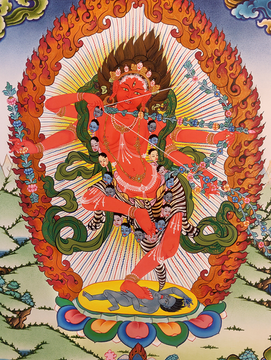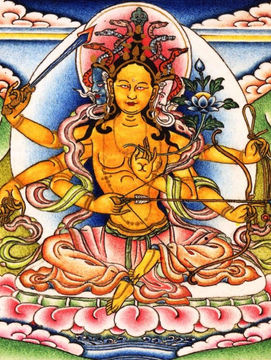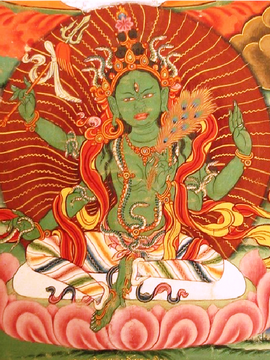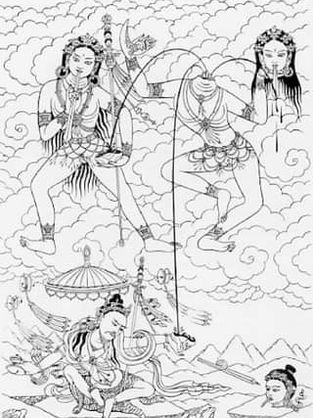
Buddhism
The Buddhist pantheon has several female Buddhas, female bodhisattvas, historical people such as lineage founders, and dharma protectors. The three major sects—Vajrayana, Mahayana, and Theravada—have their origins in India, where a wide variety of gods are revered by people in different parts of the Indian cultural continent. These deities play an essential role in various sects of Buddhism and have various deities that are symbolically similar to Hindu and regional deities.
Tara
Tara, also known as Jetsun Dölma, is a Tibetan Buddhist goddess. In Mahayana Buddhism, she is a female bodhisattva, and in Vajrayana Buddhism, she is a female Buddha. She is known as the "Mother of Liberation."
She manifests herself in multiple forms as diverse facets of the same quality. Sitatara, Shyamatara, Cintamani Tara, and Ekajati are some common Tara forms. Green Tara, also called Shyamatara, is regarded to be the original Tara and is the female consort of Amoghasiddhi, one of the Five Wisdom Buddhas. She is shown seated on a lotus with her right leg hanging down and holding a blue lotus. Tara also has 21 fundamental forms, each with its own hue and attributes. Based on this, there are five distinct systems for the various sets of Twenty-one Taras. Many famous goddesses have been included among the 21 Taras in Buddhist traditions.
(Read: Tara)
Maya, Mahapajapati Gautami & Yasodhara
Maya was the queen of King Uddhodana in the Shakya kingdom when Gautama Buddha was born. She is frequently shown in art as giving birth while standing under a tree and grabbing onto a branch overhead for support. Mahapajapati Gautami, also known as Pajapati, was the sister of Maya and she became the foster mother of Gautama Buddha after the death of Maya. She was the first female Buddhist nun. Until Gautama Buddha left his family, Yaodhar was married to him. She became a Buddhist nun and is regarded as an arahata, a highly enlightened individual.
Prajnaparamita
Prajnaparamita is frequently depicted in Buddhist art as a female bodhisattva known as Prajnaparamita Devi. She is revered as a mother goddess and represents wisdom. She is commonly depicted in a yellow or white complexion and has two or four arms. In a four-armed iconography, her two lower hands are in a meditative gesture and the upper two arms are carrying a vajara and a scripture. Another depiction shows her lower hand in a Dharma teaching gesture while the other two hands are carrying a rosary and a scripture.
Marici
Marici is a Buddhist and Taoist deity, a female bodhisattva, and a guardian deity associated with the Sun, light, or dawn. Marici is revered as a benevolent divinity who can drive out evil spirits, difficulties, and influences. She is depicted in various forms. In her most common iconography, she is depicted with a yellow complexion, three faces, and eight hands. She is sometimes depicted in white and red skin with one to six faces, seated on a boar or a horse or riding a chariot driven by seven wild boars or seven blazing horses. Due to her iconography and significance, her origins link her to the Vedic deities Usha and Surya. The majority of Buddhist practitioners around the world, especially those who practice Mahayana and Vajrayana Buddhism, recognize and worship her.
Read: Marici
Yangchenma
Yangchenma is a Tibetan form of Saraswati. She is the goddess of wisdom, knowledge, music, and arts, and is depicted in white or red color, with a lute. She is also counted among the Twenty-One Taras, depicted in a white complexion, peaceful and smiling face, and carrying a lotus a mirror marked with the syllable Hrī.
Dorje Yangchenma, also called Vajra Sarasvati, is the wrathful and fierce form of Yangchenma. She is shown in red color, with three heads and six arms. Her primary head is red, while the right head is white and the left one is dark blue. She is holding a sword, dharma wheel, book upon her utpala flower, lute, kartika knife, and brahma head.
Usnisavijaya
Usnisavijaya is a female Buddha of longevity. She is depicted with three heads, two of Amitayus (a celestial Buddha) and Sitatara (White Tara), consisting of the three Buddhas of long life. She has eight hands, carrying different attributes.
Sitatapatra
Sitatapatra is an independent goddess who protects against supernatural danger. She is depicted in multiple forms, from one face and two arms; to 1000 faces, 1000 arms and 1000 legs. She is regarded as the female counterpart of Avalokitesvara, the bodhisattva of compassion, and is thought to be manifested by Gautama Buddha from his Ushnisha.
Yeshe Tsogya & Mandarava
Yeshe Tsogyal is the highest female in the Nyingma Vajrayana lineage and the primary consort of Padmasambhava, an 8th-century Indian Vajrayana teacher. She is considered the Mother of Tibetan Buddhism considered as a female Buddha. Mandarava is the second consort of Padmasambhava and is considered the second most important female Buddha.
Yeshe Tsogyal is often shown holding a vajra or a Dadar, an arrow decorated with rainbow ribbons, and a bowl.
Prasannatara
Prasannatara is a female forms of Ratnasambhava, one of the Five Dhyani Buddhas of Vajrayana Buddhism. She is depicted in yellow color and has eight faces with three eyes in each and sixteen arms. Her front face is yellow, the second face to the right is blue, the third is green, and the fourth is blue; the face to the left is white, the second is red, and the third is blue; the face on the top is of the color of smoke, terrifying in appearance. In her right eight arms, she carries a khatvanga, uptala, arrow, vajra, ankusa, staff, kartri, and one hand in Abhaya Mudra. In her left arms, she carries a noose, kapala, bow, khatvanga, vajra, noose, the head of Brahma, and a vessel of gems.
Vasudhara
Vasudhara is the Indian bodhisattva of wealth, prosperity, and abundance. She is highly regarded among Kathmandu Valley's Buddhist Newars and she is frequently compared to the Hindu goddess Bhudevi. Vasudhara is commonly depicted in a golden or red complexion and reclining on a lotus base in the lalitasana pose and has two to six arms. Sometimes she is shown with three heads, her front face is in a golden complexion while the other two heads are in red color.
Kurukulla
Kurukulla is a Hindu-Buddhist tantric goddess and is considered a form of Tara. She is linked to bewitching, enchantment, and control. She is frequently portrayed as a young, seductive goddess with a glowing red complexion, with three eyes and four arms, holding a bow, an arrow made of flowers, a hook, and a noose of flowers. She is adorned with a garland of heads and wearing tiger skin.
Dorje Yudronma
Dorje Yudronma is a female worldly protector most commonly associated with the Drugpa Kagyu Tradition. She is depicted holding a large flat drum and striker.
Janguli
Janguli is a goddess who protects from snakes and poisons. She was worshipped in the shamanic tribes in Northern India. She is depicted in three forms. They differ in body color (white, green, and yellow) and in the number of hands and their attributes. In all her forms, she is shown adorned with snakes or holding a snake.
Samantabhadri
Samantabhadri is the consort of Samantabhadra, the ultimate Buddha. She is depicted in a pure white complexion, in contrast with the dark color of Samantabhadra.
Vishvamata
Vishvamata is the consort of Kalachakra. She is depicted in yellow colour and with 4 faces each with 3 eyes. She has eight hands, carrying a curved knife, hook, drum, mala, skull cap, lasso, lotus, and a jewel.
Nairatmya
Nairatmya is a yogini and the consort of Hevajra, a protector deity. She is sometimes independently depicted with a blue complexion and two arms holding a kartika knife and a spear.
Palden Lhamo
Palden Lhamo is a tantric wrathful Buddhist deity and a Dharmapala (Guardians of the Law), who appears in multiple forms. She is usually depicted in deep blue in color and red hair, riding a donkey. As the protector deity of Tibet and its rulers, Palden Lhamo is associated with Obstacle-Removing Mahakala. The Dalai and Panchen Lamas, as well as the city of Lhasa, are thought to be powerfully protected by Palden Lhamo.
She is also called Shri Devi, a category of female Tantric deities. In Tibetan Buddhism, Shri Devi takes on different forms. Dudsolma, one of the forms, has only one face and four arms. She carries a sword, skullcup, spear, and trident in the Sakya tradition, and a sword, skullcup, peg 'kila,' and trident in the Kagyu tradition. Another form, known as Magzor Gyalmo, is in the Gelug Tradition. It has one face and two hands, which are used to hold a skullcap and a staff with a vajra tip. In the Nyingma Tradition, there is also Dorje Rabtenma, a fierce figure with one face, three eyes, bared fangs, and a maroon or black color. She has a mongoose that spits jewels in her left hand and a sword that is on fire in her right.
Pal Lhamo is believed to be the peaceful form of Shri Devi of Buddhism or a Tibetan form of the goddess Lakshmi of Hinduism. She is usually portrayed as having a third eye, having a partially wrathful expression and white complexion, and sitting with her left leg extended. She has a bowl of jewels in her left hand and a victory arrow that has been turned upside down and tied with a mirror in her right. She is the protector of wealth.
Tenma goddesses
In Tibetan Buddhism, there are twelve guardian deities known as the Tenma goddesses. Palden Lhamo, is regarded as their peer. It is thought that these guardian Sisters live in Tibet's mountains, valleys, and ravines. One of the Tenma goddesses, Dorje Tshajema, is shown in some representations as the central figure surrounded by her sisters. At other times, they are related to Sidpa Gyalmo, the Bön goddess. The Twelve Tenma are reputed to have served as Tibet's local guardians prior to the spread of Buddhism.
Dakini
A Dakini is a type of tantric deity found in Tantric Hinduism and Vajrayana Buddhism. Dakinis can take on other forms, but they are frequently portrayed as female beings. Dakini also means female human guru, a vajra master who transmits the Vajrayana teachings or meditational deity in furious female forms. They are regarded as embodiments of enlightened energy or wisdom and are central to Vajrayana practices. They are regarded as protectors and guides for those seeking spiritual enlightenment.
Read: Dakini
Nagakanya
Nagakanya is a Hindu-Buddhist serpent deity associated with tantric traditions in India, Nepal, and parts of China. She is a Dharma protector in Buddhism. She is revered for bringing wealth, rain, protection, and aid. Naagkanya generally appears as a woman with a human torso, a serpent's body below the waist, and bird wings, with veiled cobras reigning over her crown. She carries a conch shell in her two hands.
Hariti
Hariti is a deity linked with child protection and uncomplicated birth. She is regarded as a Yakshini in South Asian beliefs. In some folklore, is also associated with misfortune and sadness toward children and parents, similar to the earlier Hindu traditions of Matrikas.
Mahamayuri
Mahamayuri is a bodhisattva and considered as the ‘Godmother of Buddha’ in Mahayana Buddhism. She is depicted riding a peacock.
Achi Chökyi Drölma
Achi Chökyi Drölma is the Dharmapala of the Drikung Kagyu school of Tibetan Buddhism and a protector in the Karma Kagyu school refuge tree as Achi Chodron.
Sukhasiddhi
Sukhasiddhi was an Indian teacher of Vajrayana Buddhism and a yogini, born in a poor family in Kashmir.
Parnasabari
Parnasabari is a Hindu and Buddhist deity of diseases, who protect against outbreaks of plagues. She is generally depicted with three heads and six hands.
Mekhala and Kanakhala
Mekhala and Kanakhala are severed-headed sisters who appear in Vajrayana Buddhism's eighty-four mahasiddhas. Both are characterized as pupils of Kanhapa, another mahasiddha. Mekhala and Kanakhala are shown naked. Mekhala, on the left, carries a skull-cup in her left hand and a sword in her right. Kanakhala holds a sword in her right hand and her own severed head in her left. In some depictions, three streams of blood erupt from Kanakala's neck, one stream of blood gets consumed by Kanakhala's head, while the others are collected in Mekhala and Kanhapa's skull-cups. Their iconography is similar to the Hindu goddess Chhinamastika.
Ten Rākṣasīs
The Ten Rkasis, also known as the "Ten Demon Daughters," are a group of Mahayana Buddhist women protectors. They assist those who adhere to the Lotus Sutra, along with Hariti. These gods serve as Samantabhadra's attendants and are held in particular esteem in the Tendai and Nichiren schools of Buddhism. They are Lambā, Vilambā, Kūṭadantī, Puṣpadantī, Makuṭadantī, Keśinī, Acalā, Mālādhāri, Kuntī and Sarvasattvojohārī.


































